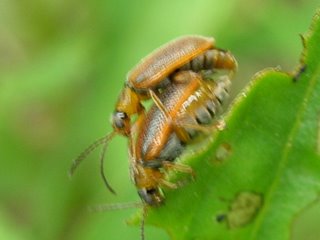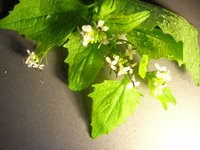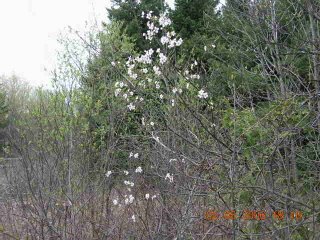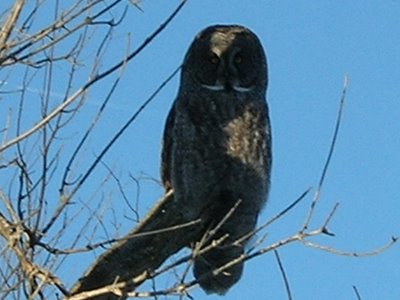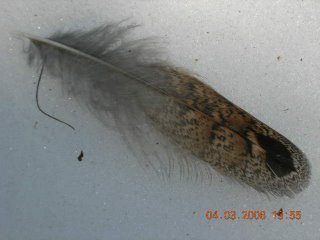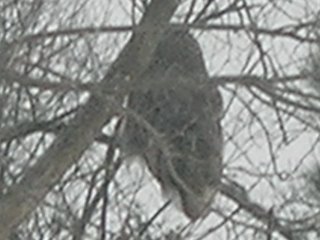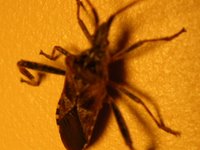Carroll and I attended the 2006 Annual General Meeting of the OWA (Ontario Woodlot Association). This year’s theme title was “Our Forests – Our Legacy” a conference for woodlot owners and managers of Ontario's private forests. It was held on March 18, 2006 in Peterborough, ON.
Some personal observations, I found the talk on “The Value of Natural Capital in Settled Areas of Canada“ particularly interesting. Much of the estimates of the Values were not very rigorously calculated however there were some very good examples given. One is New York City’s dilemma where it has to decide to invest eight billion dollars in a water treatment plant, or invest in protecting green space in the Catskill mountains where the water supply currently originates. The second option examined the cost of encouraging area farms to use natural friendly practices such as natural buffers along watercourses etc. The entire presentation is available on the Internet. If and when I find it I will post the URL here.
There were also many other titbits provided in the other presentations which I will blog post on later.
The Meeting Program as published follows:
Ontario Woodlot Association
13th Annual General Meeting and Woodlot Conference
Our Forests – Our Legacy
You are invited to attend the Ontario Woodlot Association’s annual general meeting and woodlot conference, Our Forests – Our Legacy, to be held on Saturday, March 18, 2006, in Peterborough, Ontario.
Conference Details
This year’s annual general meeting and conference will feature topics that are relevant to woodlot owners and managers from all walks of life. We’ve invited presenters who will capture your imagination and provide you with a range of information about managing your woodlot.
Here are some of the features of this year’s event.
The Value of Natural Capital in Settled Areas of Canada (Jim Anderson, Ducks Unlimited)
Natural areas provide numerous benefits that have economic value, not only for people living near these areas, but also for other communities further away. Natural areas contribute to clean water, clean air, wildlife habitat, recreation, biodiversity, erosion control, aesthetics, cultural pursuits, etc. This presentation will provide some insight into a case study where economic estimates of the values of natural areas -- natural capital -- have been developed.
Woodland Amphibians and Vernal Pools (Janine McLeod, Biologist)
Vernal pools are fascinating ecosystems with unique habitat. Fairy shrimp, wood frogs and mole salamanders are some of the species that would not survive without these small, temporary wetlands. Learn what you can do as a landowner to help conserve these important natural niches in your woodlot.
Agroforestry Opportunities for Landowners (Dr. Andrew Gordon, University of Guelph and Neil Thomas, Landowner)
Dr. Andrew Gordon will discuss some of the agroforestry options available to landowners in Ontario. Agroforestry is a way to enhance already productive agricultural operations by providing farmers with a second commodity to grow and harvest -- trees. The second part of this presentation will feature eastern Ontario landowner Neil Thomas who will tell about his personal experience with agroforestry.
Forest Songbirds in Southern Ontario (Erica Nol, Trent University)
Forest songbirds are an integral part of our forest ecosystems. The range and abundance of songbirds is determined to a large extent by the availability of suitable breeding habitat. Come and learn about some of the common forest songbirds found in southern Ontario woodlots, their habitat requirements and some of the pressures impacting their habitat and populations.
Careful Logging Practices (Martin Streit, Upper Canada Forestry Services)
One of the important steps in managing your woodlot (and in maximizing your future financial returns) is to use logging methods that will minimize the damage to residual trees and the site. This presentation will introduce landowners to a variety of careful logging practices that will help protect their woodlots.
When: Saturday, March 18, 2006
Where: Ervinrude Centre, 911 Monaghan Road, Peterborough, ON
Time: 8:30 a.m. to 4:00 p.m.
Registration: We are requesting that you pre-register for the conference. To register or to get more information, please call Rhonda at the Ontario Woodlot Association at 1-888-791-1103 ext. #221 or e-mail us at
before March 1, 2006.
Registration fee: OWA members $20.00 and non-members $25.00 (includes lunch).
Supporters of this year’s conference include: Ferguson Forest Centre, Model Forest Network, K.H. Kesso & Sons Ltd., Nelson Paint Company of Canada, and the Peterborough County Stewardship Council.
As always, guests are welcome… so bring a friend!





